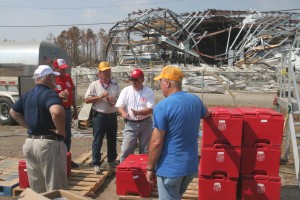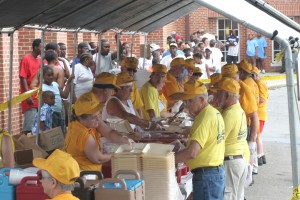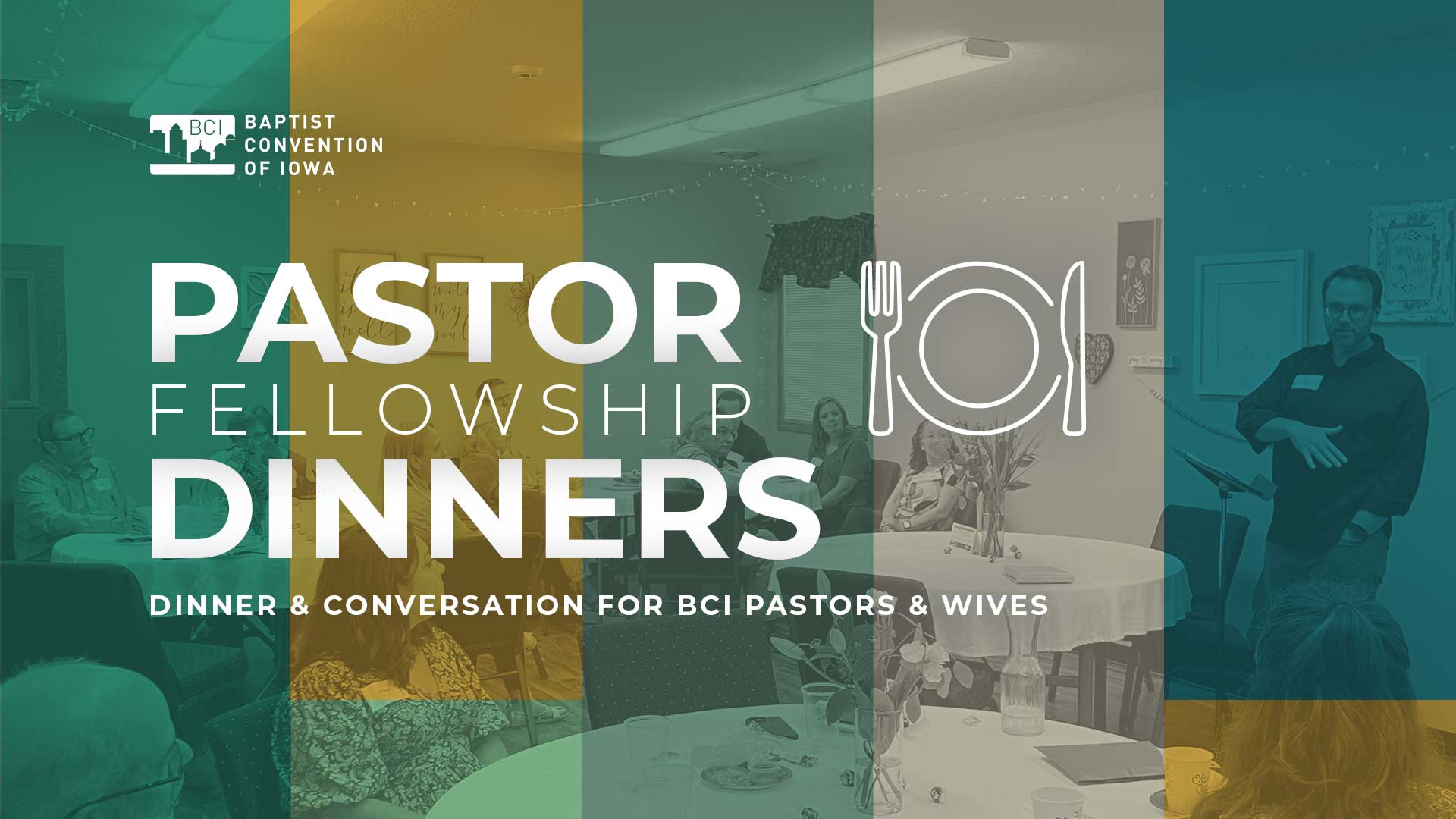by Tobin Perry

Cooperation between responding relief entities was enhanced in a number of ways through the aftermath of Hurricane Katrina. Here Southern Baptist Disaster Relief volunteers meet with The Salvation Army volunteers at an SBDR kitchen in Biloxi, Miss., to prepare Cambro containers for food distribution. File photo by John Swain/NAMB
GULFPORT, Miss. (BP) — “We’ve shared the Gospel with so many people in this community, I don’t know if there is anyone else we can share with,” Randy Corn thought to himself six months after Hurricane Katrina when he arrived in Gulfport, Miss., one of the many Gulf Coast cities devastated by the historic hurricane 10 years ago.
“I don’t know if there’s anyone else who hasn’t heard the Gospel,” Corn thought in beginning a week of Southern Baptist Disaster Relief construction projects through his church, Biltmore Baptist in Arden, N.C., which had served in the area multiple times and seen many give their lives to Christ through SBDR ministry.
Corn had prayed with the homeowner his team was serving on their first morning in Gulfport and, with his proclivity for evangelism, took a look around the neighborhood and spotted a group of young people talking at the end of a driveway.
After striking up a conversation with the group, who expressed gratitude to Southern Baptists for their relief efforts, Corn led one of the young men to faith in Christ — the first of eight people he would lead to faith in less than three hours.
Thanks in part to Corn’s experience as an SBDR volunteer following Katrina, he and his wife Ronda became North American Mission Board missionaries and have spent much of the past decade helping train SBDR teams in personal evangelism.
Corn, who served on his first SBDR team just days after Katrina’s onslaught, was one of nearly 21,000 volunteers from 41 Baptist state conventions to participate in Baptist relief efforts that began after the hurricane’s Gulf Coast landfall on Aug. 29, 2005, and continued through March 2006. Another 26,000 volunteers would participate in Operation NOAH (New Orleans Area Homes) Rebuild from March 2006 to April 2009. The influx of new volunteers — by far the most who would ever participate in a single SBDR response and rebuild effort — would transform future disaster relief efforts by Southern Baptists.

One of the most striking images from the hundreds of church facilities damaged by Hurricane Katrina was the gutted sanctuary of First Baptist Church in Gulfport, Miss. The church would choose to move from its home of 110 years, two blocks from the beach, and relocate inland three miles to rebuild. Providentially the church had increased its storm insurance in the year prior to the storm. File photo by Brian Korosec/NAMB
Fritz Wilson, executive director of disaster relief for the North American Mission Board, calls Hurricane Katrina one of a handful of transformational events in the history of SBDR — from its inception in 1967 during Hurricane Beulah to the Southern Baptist response after the 9/11 terrorist attacks. Yet no response remotely compares to Hurricane Katrina.
“Everyone has their own list of what were the most influential events in SBDR,” Wilson said. “But everyone has Katrina as the watermark event in the history of the ministry.”
Within the first five years after the hurricane, the number of trained volunteers soared by 46 percent — from 51,300 to 95,000 volunteers – with more than 25,000 new volunteers trained in the first few months after the hurricane.
“The disaster relief teams of the SBC are second to none,” said former SBC President Fred Luter, pastor of New Orleans’ Franklin Avenue Baptist Church for nearly three decades. “I don’t just say that for what I’ve heard or read about. I say that because of what I’ve seen firsthand.
“Being there in New Orleans after Hurricane Katrina, I saw missionaries and disaster relief volunteers come here from all over the country to help those of us in the city, whether it was to gut out our homes or our churches or to help us to paint or cut grass,” said Luter, president of the SBC from 2012-14.
Mickey Caison, who directed SBDR efforts when Hurricane Katrina hit, noted the additional volunteers vastly increased SBDR’s capacity and boosted its standing among fellow disaster relief organizations.

Hurricane Katrina evacuees were spread across the Gulf Coast. Here Southern Baptist Disaster Relief volunteers prepare a meal in Meridian, Miss. In total, SBDR volunteers prepared 14.6 million hot meals in the response. File photo by John Swain/NAMB
“There was a significant change in the perception of Southern Baptists coming out of Katrina,” Caison said. “We went from an organization that worked with Red Cross and FEMA to an organization worthy of a relationship and a commitment from FEMA. It gave us a different kind of credibility in the eyes of emergency managers and government officials.”
With reports by national media outlets such as The Wall Street Journal, awareness of Southern Baptist Disaster Relief rose throughout all levels of government.
“It opened doors that normally we couldn’t even get close to knocking on,” said Jim Burton, director of volunteer mobilization at the North American Mission Board at the time. “We got much, much better at telling our story through secular media. Then when the government got around to doing a report in 2006 to evaluate what had happened, they were all over the Southern Baptist Disaster Relief response with praise, according to what had been accomplished there.”
Burton noted that SBDR’s Katrina efforts became a model for other organizations, even secular ones. As an example, he pointed to a national organization for project management professionals that asked him to write a textbook chapter titled, “A Faith-Based Response to Catastrophic Disaster: An Overview of Southern Baptist Disaster Relief Planning and Logistics in Hurricane Katrina.”
“What most observers could not understand or measure was the sense of call our volunteers had to serve Katrina survivors,” Burton added. “That obedience to God’s purpose for them as individual Christian volunteers drove our commitment to excellence and caring.”

Southern Baptist Disaster Relief volunteers clear debris from a home in Pascagoula Miss., flooded by Hurricane Katrina. Destruction and damage from the storm spread 90,000 square miles and destroyed or made uninhabitable 300,000 homes. File photo by John Swain/NAMB
SBDR volunteers returned home with a new passion for disaster relief — as well as for New Orleans and the Gulf Coast. And some stayed, making a Gospel-sized impact on their new home.
James Welch was finishing his studies at Southern Baptist Theological Seminary in Louisville, Ky., when Katrina hit the Gulf Coast. The following June, Welch’s family joined a team from Louisville’s Sojourn Community Church in moving to New Orleans to serve the city and dream about a future church plant.
For the first several years, Welch simply served, often through SBDR, putting up sheetrock and painting — and telling people about Jesus when the opportunity came up. Three and a half years after Katrina, Welch and his team began to explore locations for a church plant. Local Southern Baptists connected Welch with Lakeview Baptist Church, a declining church that had been hit hard by Hurricane Katrina.
The connection proved to be a “win-win” opportunity for Welch, his team and the declining church. The new church, Harbor Community Church, which formed from the partnership, has grown to nearly 300 worshippers. Yet the young church’s success has been about more than numbers — it’s also been a growing symbol of a city reborn, a living picture of the Gospel.
“Before Katrina, evangelicals were largely seen as a group of people who were just coming to New Orleans to convert people or to tell people what they shouldn’t do,” Welch said. “After Katrina, New Orleans people see a more Gospel-centered view of an evangelical. Meaning that evangelicals come because they understand their own brokenness and they understand the brokenness that happens within culture and community, and they’re here to present this Gospel of reconciliation.”
Today, Southern Baptists have 65,000 trained volunteers — including chaplains — and 1,550 mobile units for feeding, chainsaw, mud-out, command, communication, childcare, shower, laundry, water purification, repair/rebuild and power generation. SBDR is one of the three largest mobilizers of trained disaster relief volunteers in the United States, along with the American Red Cross and The Salvation Army.
NAMB coordinates Southern Baptist responses to major disasters in partnership with 42 state Baptist conventions, most of which have their own state disaster relief ministries.
Those wishing to donate to SBDR relief ministries can contact the Baptist convention in their state or visit https://donations.namb.net/dr-donations. For phone donations, call 1-866-407-6262 or mail checks to NAMB, P.O. Box 116543, Atlanta, GA 30368-6543. Designate checks for “Disaster Relief.”
Tobin Perry writes for the North American Mission Board.






